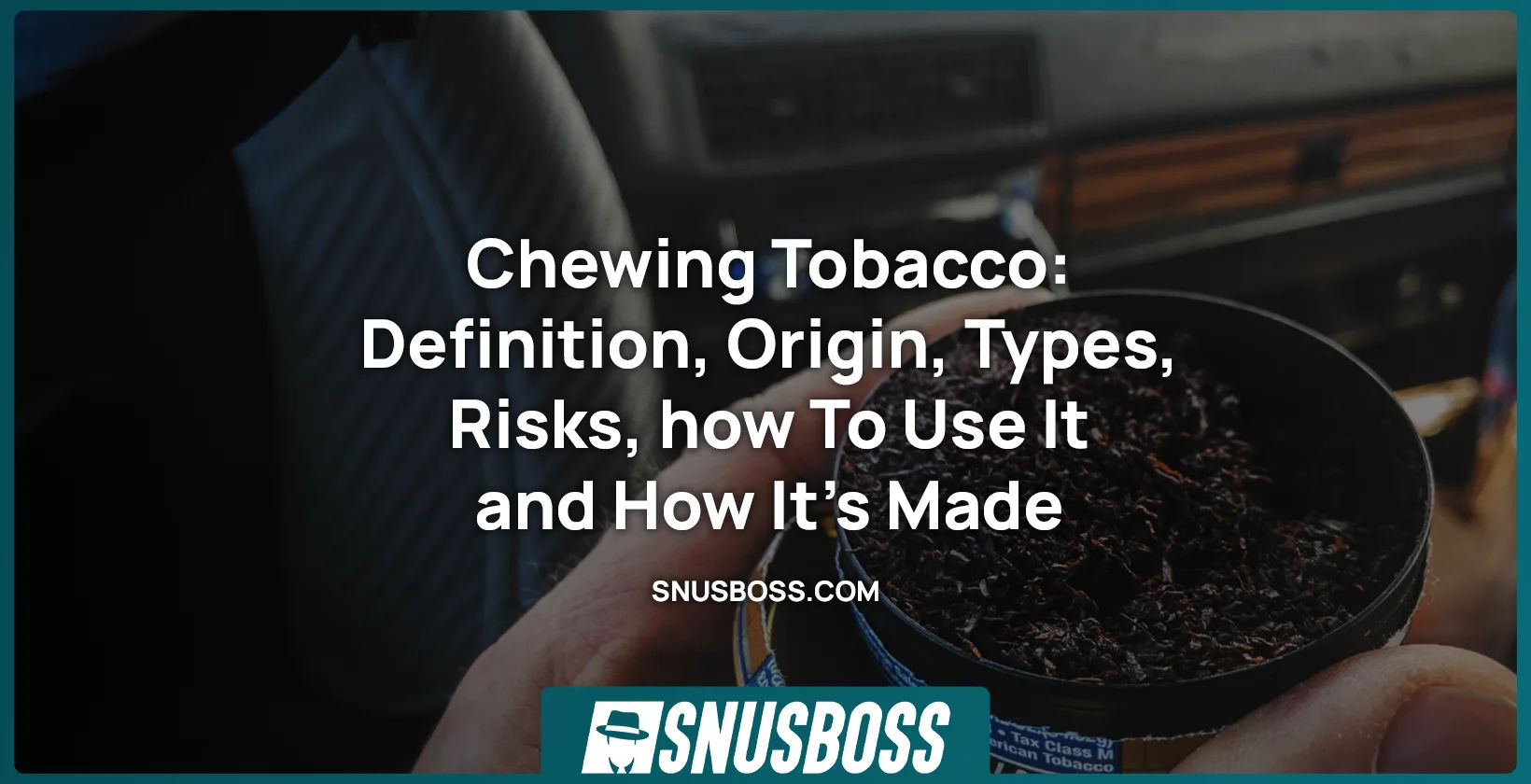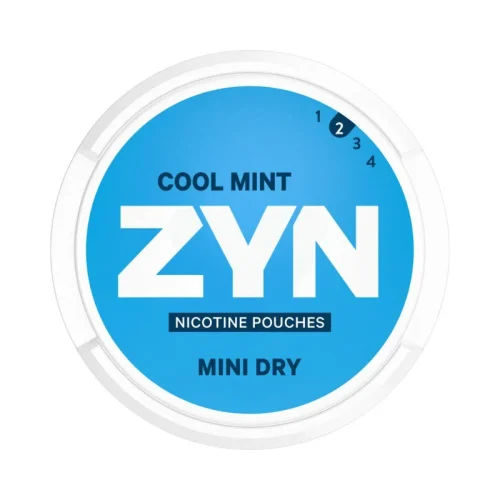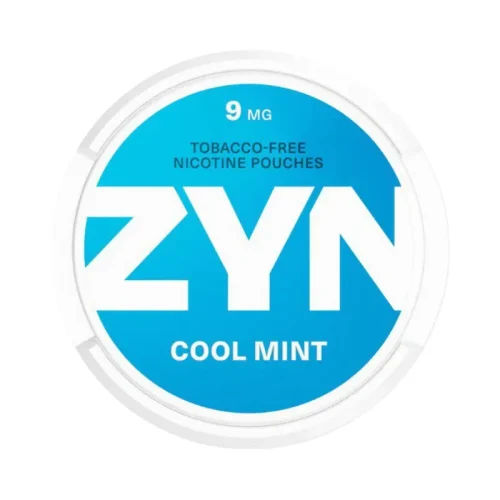Chewing tobacco is made from tobacco plant leaves and belongs to the smokeless tobacco product category. Chewing tobacco is one of the oldest forms of consuming tobacco. The first written sources about chewing tobacco were written by Columbus in 1571. Chewing tobacco originates from the American native tribes. Chewing tobacco has been used due to the nicotine “high” it delivers.
There are three types of chewing tobacco available: loose leaves, plugs (bricks), and twists of rope. All these types have different texture and flavor intensity. There are different tobacco chew brands to choose from. Chewing tobacco is available in different flavors and strengths, but these options are not as wide as with other nicotine products (nicotine pouches, vapes). Chewing tobacco is made by curing, fermenting, flavoring and sweetening the tobacco leaves.
For using chewing tobacco, you have two different ways, of course you can combine those two ways. The first option is to take the tobacco and to chew it (about 30 minutes max). The second option is to take the chewing tobacco and park (place) it between the gum and the lip. Nicotine from chewing tobacco gets into your system in two ways: through the lining of the mouth and a tiny amount with the saliva you swallow.
Using chewing tobacco has a lot of risks. It is bad for the cardiovascular system: raises blood pressure, heart beats, and narrows blood vessels. That leads to lack of oxygen in your blood and other organs. Chewing tobacco consumption also possesses risks to your psychological health and wellbeing. It increases the risk of developing ADHD, stress, anxiety, panic disorders and specific phobias. Chewing tobacco is also harmful to your oral health.
What Is Chewing Tobacco?
Chewing tobacco is a type of smokeless tobacco made from cured tobacco leaves as defined by the National Cancer Institute. Chewing tobacco has been used at least since the 1500s in Central America. It is one of the oldest ways for consuming tobacco. Columbus noted in 1571 about men in nowadays Costa Rica area who were putting plants in their mouths and chewing them (Heimann, 1960). Chewing tobacco consists of coarsely divided tobacco leaves that are mixed with sugar and flavorings and then packaged. Chewing tobacco contains nicotine and that makes iot highly addictive. Chewing tobacco is available in different forms: loose leaves, plugs (bricks), and twists of rope. Chewing tobacco is chewed or/and placed between the lip and the gum.
How Do Chewing Tobacco Is Used?
Chewing tobacco is used in two ways that can be either combined or done separately according to your preferences. Firstly, you can chew the chewing tobacco tobacco. Secondly you can place (park) the chewing tobacco between the gum and the lip. You can swallow the saliva from the mouth or spit it out. The nicotine from the chewing tobacco enters your system through the mouth lining and when you swallow the saliva that contains nicotine. Majority of nicotine gets into your system through the mouth lining. The nicotine delivery through saliva is not as effective because the saliva ends up in the stomach where the acidy stomach content will destroy most of the nicotine content before it enters the system. Chewing tobacco is smokeless, it is not meant to be smoked.
What Are the Different Types of Chewing Tobacco Products on The Market?
Different types of chewing tobacco on the market are:
- Loose leaves: you chew or park dried tobacco leaves. Most popular form of chewing tobacco.
- Plugs(bricks): the leaves are crumbled into smaller pieces, mixed with sweeteners and flavorings and then shaped into brick like shapes. You take pieces of it and chew or park them.
- Twists of rope: the leaves are crumbled into smaller pieces, mixed with sweeteners and flavorings and then shaped into twists of rope. You take pieces of it and chew or park them. In this form the chewing tobacco is much harder to chew on.
What Is the History and Cultural Significance of Chewing Tobacco?
Chewing tobacco has long historical and cultural significance. Chewing tobacco was first mentioned on paper by Columbus who made a note of it in his journal. He wrote that local (nowadays Costa Rica) men were chewing on tobacco plants (Heimann, 1960).
Chewing tobacco had a high price for centuries afterwards when it came to selling and buying American products. Tobacco plantation owners were among the richest merchants in America (both in the South and North America). Tobacco made money mostly for the merchants and plantation owners.
Users of tobacco had no such limitations. Using chewing tobacco joined everyone from the poor slaves to the president. Chewing tobacco was common both on the street and even in the churches. Using chewing tobacco connected the soldiers in the American Revolutionary War from all origin, everyone was equal while chewing tobacco and sitting by the campfire. Although today everyone can use chewing tobacco if they are at least 21 years old then still the majority of chewing tobacco users are male.
How Is Chewing Tobacco Made?
Chewing tobacco is made in a quite simple way. The simple way of creating chewing tobacco makes sense due to the long time period (hundreds of years) that chewing tobacco has been used. The production of chewing tobacco is simple enough to do it without the need for machines. Nowadays machines are involved in the production of chewing tobacco due to the amount of chewing tobacco being created and health standards they need to keep in order to sell them to the public.
Firstly, tobacco plants are being grown. Then the leaves of tobacco plants are removed and cured (dried and aged). After that leaves are cut into suitable sizes. Then the pieces are fermented (left to age to stabilize chemicals in the tobacco leaves). After this comes flavoring and sweetening of the product. The last step of the product process before packaging is the shaping of chewing tobacco into wanted form. Packaging of the prepared product is also a crucial step due to the photosensitivity of nicotine in the tobacco. The production of chewing tobacco is quite simple but all the steps are necessary for sending a quality product to the market. Tobacco industry is extremely competitive and quality products are essential to stay on the market.
What Is the Economic Impact of Chewing Tobacco for the Tobacco Industry?
Chewing tobacco is having a growing impact on the tobacco industry. At the moment chewing tobacco has the highest compound annual growth rate (8.4%) among smokeless tobacco products as reported in the 2019-2025 Market Analysis Report (Grand View Research). It is due to the growth of the middle class and economic difficulties people are trying to find cheaper ways to consume tobacco. Chewing tobacco is an old classic that already has hundreds of years of marketing done and now it is coming back strong to take back its place as one of leading tobacco products.
What Are Law and Regulations Regarding Chewing Tobacco?
Law and regulations regarding chewing tobacco are the same as with other tobacco products. You must be at least 21 years old to buy or consume chewing tobacco, that law was enforced in 2019. Retailers of chewing tobacco need to verify age by photographic identification for all over-the-counter tobacco sales. Chewing tobacco producers or sellers are prohibited from name brand sponsorship of sporting or other cultural events for chewing tobacco. Retailers need to keep chewing tobacco products behind the counter. The sales of chewing tobacco in shops need face-to-face connection (no vending machines). It is prohibited to give free gifts with chewing tobacco purchases. There are advertising and packaging regulations for chewing tobacco (as well as other tobacco and nicotine products) that are regulated by the FDA (the U.S. Food and Drug Administration).
What Are the Health Risks Associated with Chewing Tobacco?
The health risks associated with chewing tobacco are:
- Cancer: Chewing tobacco has high levels of chemicals and other substances that cause cancer (mostly mouth and throat cancer). It also causes tumors in the mouth area that can develop into cancers.
- Tooth decay and mouth sores: The sugar content and acidity of chewing tobacco cause tooth decay and painful mouth sores.
- Poor gum health: the acidity and sugar content of chewing tobacco damage gums.
What Are Long Term Effects of Chewing Tobacco?
The long-term effects of chewing tobacco are:
- Addiction: Chewing tobacco contains nicotine. Nicotine is a highly addictive substance that leads to addiction.
- Teeth and gum problems: tobacco stains teeth, the sugar content and acidity of chewing tobacco damages gums and teeth.
- Formation of leukoplakia (white patches/ growths/ tumors in the mouth) that can develop into cancers.
- Cardiovascular problems: nicotine raises blood pressure and heart rate, narrows blood vessels.
- Oxygen levels in organs and blood get lower: nicotine leads to lack of oxygen in the blood and that means that organs get less oxygen and malfunction.
Read more about Effects of Snus to your Body.
What Are the Withdrawal Symptoms of Quitting Chewing Tobacco?
The withdrawal symptoms of quitting chewing tobacco are:
- Fatigue: Fatigue is a condition marked by extreme tiredness and inability to function due to the lack of energy. Chewing tobacco contains nicotine. Nicotine is a stimulant drug and gives you energy. When you are not using nicotine, you will feel more tired.
- Constipation: Constipation is a condition in which there is difficulty in emptying the bowels, usually associated with hardened feces. Chewing tobacco contains nicotine. Because nicotine promotes the movement of feces through the intestinal tract, withdrawal from using it causes difficulty with bowel movements, as stated by Medical News Today (2022).
- Headaches and Dizziness: Headache is a continuous pain in the head. Dizziness is a sensation of spinning around and losing balance. These are usually the first symptoms to appear when you quit using chewing tobacco and the first to go away.
- Cravings for chewing tobacco: Cravings for chewing tobacco are defined as persistent urges, thoughts or desires to consume chewing tobacco by Cambridge Dictionary. The cravings will get easier after 3-5 days. But this symptom of chewing tobacco withdrawal will last for the longest, usually the craving will last a bit more than 15 minutes.
- Appetite: Appetite is defined as the feeling that you want to eat food. Using nicotine containing chewing tobacco makes your body produce serotonin and dopamine, which reduce the feeling of hunger. Now that serotonin and dopamine levels are lower you will feel hungrier.
- Irritation: It means being annoyed or angry. It comes from chewing tobacco no longer producing serotonin and dopamine to make you feel happier.
- Restless: Being restless means that you are unwilling or unable to be quiet and calm. Being restless happens because your brain is missing the stimulation that the nicotine in chewing tobacco produces.
- Lack of Concentration: Lack of concentration is defined as not being able to think carefully about something you are doing by Cambridge Dictionary. You are unable to concentrate because there is no more alertness created by the nicotine in the chewing tobacco.
- Trouble with sleep: Trouble sleeping means it is hard to fall asleep, hard to stay asleep, or cause you to wake up too early and not be able to get back to sleep. Because nicotine from chewing tobacco had kept your hormone levels different from your natural state, the body needs time to rebalance. That means the sleep cycle that is directly linked to hormone levels is off balance and that is why you have trouble with sleeping.
- Anxiety and depression: Anxious is defined as being worried or nervous. Depressed is defined as unhappy or without hope by Cambridge Dictionary. Nicotine from chewing tobacco makes you less stressed and depressed by making your body produce more dopamine and serotonin “the happy hormones”. Now that you are no longer using chewing tobacco anxiety and depression will get a bit bigger.
Luckily all those effects are temporary (2 – 4 weeks) and after that period is over your hormones will normalize and you will feel less stress, anxiety and depression than you did while using chewing tobacco as stated by different researchers.
Read more about Nicotine Withdrawal.
What Are the Psychological Effects of Chewing Tobacco?
The psychological effects of chewing tobacco are:
- Greater odds for developing panic disorder and specific phobias as reported in the 2014 Clinical Study carried out by Q. Fu, M.G. Vaughn, L. Wu and A.C. Heath.
- Increases levels of depression, anxiety and stress as stated by the WHO (World Health Organization). It happens because in the long run using nicotine tells your brain not to produce dopamine without its presence.
- Increases likelihood of having ADHD (attention deficit hyperactivity disorder) since nicotine messes up your natural hormone production then it is off balance. That increases the likelihood of having ADHD or the level of ADHD you have.
How Does Chewing Tobacco Increase the Risk of Oral Cancer?
Chewing tobacco increases the risk of oral cancer because of the substances in the chewing tobacco. When you chew chewing tobacco the chemicals in the chewing tobacco create a suitable environment for growth of leukoplakia (white spots, tumors). Those can eventually turn into a suitable environment for cancer. Different people react to chewing tobacco chemicals differently in different time periods. You may get oral cancer after using chewing tobacco for a few weeks, some do not get it after using chewing tobacco for years. The one way to avoid oral cancer caused by chewing tobacco is to not use chewing tobacco.
How Does Chewing Tobacco Affect Cardiovascular Health?
Chewing tobacco affects cardiovascular health in a bad way. Chewing tobacco contains nicotine. Nicotine is a highly addictive substance that has a negative effect on your cardiovascular health. Nicotine raises blood pressure, makes your heart race, arteries narrow and it can increase the flow of blood to your heart, according to the American Heart Association (2021). Think of your cardiovascular system as a car suddenly speeding up to 100 miles per hour, the same way as this speeding is not sustainable for the car it is not sustainable for your heart. All of this leads to less oxygen in your organs that damages them additionally.
How Does the Use of Chewing Tobacco Affect Pregnancy?
The use of chewing tobacco shortens the length of pregnancy. Using chewing tobacco while pregnant will also decrease the birth weight. According to a report carried out in 2002 by Dr P.C. Cupta and Dr S. Sreevidya the pregnant women who really need special care for using smokeless tobacco products while pregnant are in developing countries. In developing countries smokeless tobacco is considered healthy due to the lack of smoke and burnt tobacco. Chewing tobacco is dangerous for both pregnant women and their unborn children. In other words chewing tobacco affects pregnancy only in a bad way.
How Much Is the Nicotine Content of Single Chewing Tobacco Compared to A Cigarette?
Single chewing tobacco contains more nicotine than a cigarette. Chewing tobacco for 10 minutes equals one cigarette (1 mg of nicotine on the average). Chewing tobacco nicotine content is stronger than cigarettes. Although chewing tobacco is burnt tobacco and smoke free it is still important to remember that it contains nicotine and other harmful substances. Nicotine is a highly addictive substance and the best thing would be to stop using all nicotine products.
Read more about What is Nicotine.
How Does the User Experience of Chewing Tobacco Differ from Smoking Tobacco?
User experience of chewing tobacco differs from smoking tobacco by speed, flavor and taste experience. Chewing tobacco delivers more nicotine to the consumer but at a slower pace than nicotine. When you smoke tobacco, you taste burnt tobacco and smoke with chewing tobacco those are missing. With chewing tobacco, you feel the taste of tobacco leaves, sweeteners and flavorings. Chewing tobacco contains no smoke or burnt tobacco but it still contains nicotine and other harmful substances. Not using any nicotine products is the healthiest option.
Is Chewing Tobacco Used to Quit Smoking?
Yes, chewing tobacco is used to quit smoking. Chewing tobacco is smokeless and burnt tobacco free so it seems more pleasant and healthier to people who try to quit smoking. Chewing tobacco still contains nicotine and other harmful chemicals. The best option would be to contact your doctor and find a healthier way to quit smoking.
Does Nicotine Cause Cancer?
No, nicotine does not cause cancer according to WHO (World health Organization). Burnt tobacco and smoke have been found to cause the majority of nicotine related cancers. Nicotine does not cause cancer but is highly addictive and makes you consume substances that contain chemicals that eventually lead to cell mutations (including cancer). When you use chewing tobacco you are at higher risk of getting oral cancer.
Can Minors Buy Chewing Tobacco Products?
No, minors cannot buy chewing tobacco products. Under the federal law (also known as Tobacco 21 or T21) it is illegal to sell tobacco products to anyone who is under 21 years old. The law also states that you have to be at least 21 years old to buy or consume tobacco (nicotine) products in the USA.
Is Chewing Tobacco Addictive?
Yes, chewing tobacco is addictive. Chewing tobacco contains nicotine. Nicotine is a highly addictive substance due to the “high” that nicotine product user experience. Nicotine makes the user feel both alert and sedated at the same time. Nicotine is what makes chewing tobacco addictive to its users. Using chewing tobacco is not healthy and when you wish to quit using chewing tobacco you should contact your doctor to find the healthiest way for quitting.





